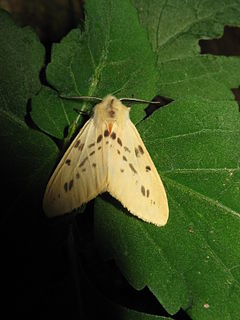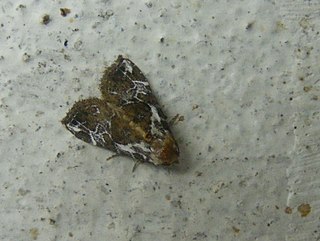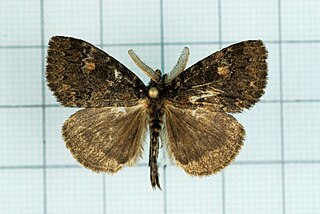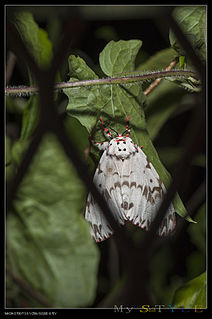
Celaenorrhinus is a genus of skipper butterflies which are commonly termed sprites. An alternate name is flats, for their habit of holding their wings flat when resting, but this is also used for related genera. They belong to the spread-winged skipper subfamily (Pyrginae), and therein are the type genus of tribe Celaenorrhini.

Lemyra is a genus of tiger moths in the family Erebidae. The genus contains many species from East and South Asia, Sundaland and Australia. It was described by Francis Walker in 1856.

Chorsia is a genus of moths of the family Erebidae. The genus was erected by Francis Walker in 1863.

Cidariplura is a genus of moths of the family Erebidae. The genus was erected by Arthur Gardiner Butler in 1879.
Gerbathodes is a genus of moths of the family Noctuidae. The genus was described by Warren in 1911.

Pangrapta is a genus of moths in the family Erebidae. The genus was erected by Jacob Hübner in 1818.

Paracolax is a genus of litter moths of the family Erebidae. The genus was erected by Jacob Hübner in 1825.
Sinarella is a genus of moths of the family Erebidae. The genus was erected by Felix Bryk in 1949.

Ilema is a genus of tussock moths in the family Erebidae. The genus was described by Walker in 1855 and renamed by Moore in 1860, because Walker's chosen name was preoccupied.

Lymantria mathura, the rosy gypsy moth, is a species of moth of the family Erebidae found in the Russian Far East, Nepal, Japan, the Korean Peninsula, northern India and China. The species was first described by Frederic Moore in 1866.

Hypsopygia nannodes is a moth of the family Pyralidae described by Arthur Gardiner Butler in 1879. It is found in Taiwan, Japan and Korea.

Hypsopygia regina is a species of snout moth in the genus Hypsopygia. It was described by Arthur Gardiner Butler in 1879 and is known from Korea, Japan, Myanmar, India and Russia.

Lemyra venosa is a moth of the family Erebidae first described by Frederic Moore in 1879. It is found in India in Sikkim and the Khasia Hills and in Bhutan.

Lemyra punctilinea is a moth of the family Erebidae first described by Frederic Moore in 1879. It is found in Sichuan, Shaanxi, Yunnan, Pakistan, Kashmir, the Himalayas, Assam and Nepal.
Lemyra obliquivitta is a moth of the family Erebidae. It was described by Frederic Moore in 1879. It is found in China, Nepal, Bhutan, India, Myanmar and Thailand.
Lemyra bimaculata is a moth of the family Erebidae. It was described by Frederic Moore in 1879. It is found in eastern India and Nepal.

Lemyra imparilis is a moth of the family Erebidae. It was described by Arthur Gardiner Butler in 1877. It is found in China, Taiwan, Japan and Korea.
Lemyra infernalis is a moth of the family Erebidae. It was described by Arthur Gardiner Butler in 1877. It is found in China, Taiwan, Japan and possibly Assam, India.
Lemyra sikkimensis is a moth of the family Erebidae. It was described by Frederic Moore in 1879. It is found in India and China.
Neoploca is a genus of moths belonging to the subfamily Thyatirinae of the Drepanidae. It was first described by Shōnen Matsumura in 1927. It contains only one species, Neoploca arctipennis, first described by Arthur Gardiner Butler in 1878, which is found in Japan, Korea, the Russian Far East and China.













